Urban environment
The city fauna
A lot of animals have found in the city of Venice a hospitable place where
to live, and the reasons that have led them to this choice can be listed
in the following way:
-
In the city the animals find the gorges and the
niches that are missing in the surrounding natural
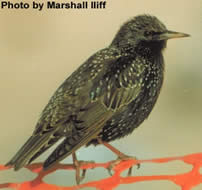
environment: the common swifts ( Apus
apus), the pigeons ( Columbia
livia), the starlings ( Sturnus
vulgaris), the bats and other birds take shelter in
the lofts, among the tiles of the roof and the cracks of the houses.
-
-
-
The city of Venice is situated in
the middle of a lagoon that is one of the most important humid areas
in Europe, with regards to the number of the species and of the individuals
of wintering,
nest-building
and non-migratory
birds that it holds. It is unavoidable, then, that the town itself
is subject to the passing and stopover of some birds.
The city flora
When you think about the city flora,
most of all in a city such as Venice is, the public gardens or the private
ones, beautiful green corners hidden within the courtyards come to mind.
But there is a smaller and less hidden world that discloses to the eyes
of the most careful observers and that populates the banks, the fondamenta
and the city walls.
On the bank walls, in the strip of the water sprinklings still influenced
by the presence of the brackish water of the canal, species accustomed
to the salt environments as the sea fennel (Crithmum
maritimum), the sea lavender (Limonium
vulgaris) the hastate orache (Atriplex
hastata) can be found.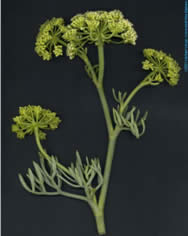
Swimming up to the bank you reach the border of the fondamenta: there,
as they are so near to the canal, the treading down causes less trouble
and the plants can reach bigger dimensions. Moreover, the influence
of the salt water of the canal decreases, while the level of organic
matter, hoarded up in the cracks among the stones increases.
In this area the amaranth (Amaranthus
retroflexus), the lamb’s quarters (Chenopodium
album), the Bermuda grass (Cynodon
dactylon), the dandelion (Taraxacum
officinale) can be found.
Moving to the inside of the fondamenta, the trouble caused by treading
down increases and therefore both the species and the growth of the
plants change. There, smaller plants usually flattened down to the ground,
with small flowers and leaves that can survive to the treading down
taking shelter into the cracks among the stones, can be found.
The Greater plantain (Plantago
maior), the Birdseye pearlwort (Sagina
procumbens) and the Knotgrass (Poligonum
aviculare) belong to this community.
Along the walls or on the sides of the bridge steps, where the trouble
caused by treading down is the lowest and some mould is hoarded up,
another kind of vegetation develops. The horseweed (Conyza
canadensis), the shepherd’s purse (Capsella
bursa – pastoris), the bittercress (Cardamine
hirsuta), the squirrel-tail grass (Hordeum
murinum), the annual blue grass (Poa
annua), the common groundsel (Senecio
vulgaris), the kitchen-garden purslane (Portulaca
oleracea), the vervain (Verbena
officinalis) can be found there.
Other plants do not have to face the problem of treading down, as they
grow up on the walls of the houses and on the arches of the bridges.
The most common of these is the Pellitory of the wall (Parietaria
officinalis), ollowed by the Kenilworth ivy (Cymbalaria
muralis). The first organisms to colonize the walls
of the building and of the bridges are the lichens,
that are able to crumble the rock and to prepare the ground for other
more demanding plants.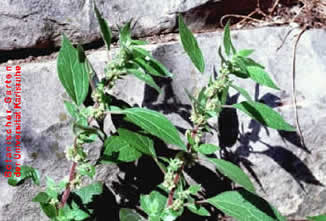
LThe plants that can be found in the city have several methods to be
able to survive to the winter: in some of them (Emicryptophyte)
the leaves keep on growing as a basal
rosette, that, being flattened down, exploits the heat coming
from it and is protected by the dead leaves of the plant itself. Some
others (Terophyte)
spend the winter as seeds that germinate only when conditions become
favourable.
The seed
dispersal is made efficient by both the elevated quantity
of seeds, that ensures more chances of success and by the typology of
the seeds, that are often provided with a pappus
or are very light anyway. These strategies let the seeds reach favourable
environments, even if they are very far from the mother plant.
Venice
canals
In order to discover a particular typology of flora
and fauna
in the Venice lagoon, it isn’t always necessary to look for special environments,
but it is enough to look at the banks of the canals that run through the
city more carefully.
A big variety of both animal and vegetable organisms populate the banks,
both above and below the water level.
The best period for observation is springtime, when the biological activity
of the organisms reaches the highest levels, and especially during the
phases of low tide,
when the visible strip is the largest.
The bank environment of the Venice canals can be divided into three easily
distinguishable strips:
The
strip of the water sparkling
This strip is reached by the sprinklings of the water, and only occasionally
is affected by exceptional tides.
Its width varies, according to the intensity of the wave
motion , from 50 to 100 centimetres.
It is populated by highly specialized organisms: the ground organisms
must be able to bear the salinity
and the periodical floods, while, on the contrary, the sea ones must
be able to resist during the long periods of emersion.
On the upper part of the walls along the canals, but also on the steps
of the watergates of the palaces, you can see a green patina, made up
of the green microscopic algae
that indicate the maximum height the sprinklings can reach.
The first animal organisms that can be found in this strip are the air-breathing
isopod crustaceans:
the Italian sea roach (Ligia
italica) and the Sea slater. Both are very similar to
the woodlice, but the sea roach is distinguishable for the speed with
which it goes back when the wave comes.
In the area 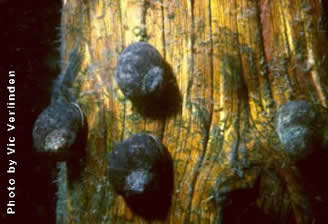 of transition between the strip of the water sprinklings and the one below
the common periwinkles that are gastropods
molluscs (Littorina
littorea) live. These snails live on more stable substrata
than the bricks, that are easily friable, and therefore most of all on
the stones that offer a good and constant presence of the seaweeds,
that represents their food.
of transition between the strip of the water sprinklings and the one below
the common periwinkles that are gastropods
molluscs (Littorina
littorea) live. These snails live on more stable substrata
than the bricks, that are easily friable, and therefore most of all on
the stones that offer a good and constant presence of the seaweeds,
that represents their food.
They live in small groups in the area that is regularly under water during
the high tide, and so they are observable both with medium and low tide.
During wintertime they take shelter in the narrow cracks that are not
reached by the water, and even if they are a sea species they can resist
to relatively long periods of emersion.
In this area the Enteromorpha (Enteromorpha
intestinalis), can be found, that here gets accustomed
to the difficult conditions due to the periodical emersions reducing its
development to a minimum.
The
strip of tidal excursion
This strip, often called intertidal area, in Venice is about 1 metre thick.
One can find Crustaceans
that stick directly to the substratum and that can even be found hoarded
up one against the other on the stakes embedded in the caranto (a hard
layer of clay).
The Acorn shells are cirriped crustaceans. That means that they are provided
with limbs that are employed to create small whirlpools in order to convey
the food towards their mouth. They don’t look like other cirripeds, as
the adaptation to a sedentary life has determined several changes and
only during their youth stage these organisms can be seen swimming freely.
The more abundant and characteristic species that can be found along Venice
canals are the Striped barnacles (Balanus
amphitrite) and the Poli's stellate barnacles (Chthamalus
stellatus).
Mussels can often be seen being attached to the valves
.
They can bear periodical emersions thanks to two small mobile plates situated
on the top of their body, that allow on one hand the contact with the
outside when they are submerged and on the other to isolate, keeping in
the inside the surrounding water environmental conditions during the emersions.
Besides the acorn shells, the Limpets
(Patella
coerulea), gastropods
molluscs, can be found. Their shell perfectly fits to the substratum on
which it is situated thanks to its muscular foot,
that perfectly sticks at it, and this strategy has a double aim: to defend
from possible aggressions and to keep a sea water supply inside the shell
in the periods of emersion.
In this environment the seaweeds find the most suitable situations to
their development, and the number of different species increases.
The Enteromorpha
reaches its maximum vegetation
development, and the red alga (Porphyra
leucosticta), banded weeds (Ceramium
rubrum), and the green laver sea lettuce (Ulva
lactuca) make their appearance too..
The Enteromorpha and the green laver sea lettuce are green alga, while
the Porphyra and the Ceramium are red alga, whose presence is justified
by the fact that the water in the Venice canals is very muddy and doesn’t
allow the wavelenght
of the green band to penetrate, while the green band can cross the
column of water without suffering great absorptions.
Among these seaweeds the Crustaceans as the
Green Crab, whose females are called masanete, can be found. These decapods
can be found in the canals especially in spring, when they move from
the sea to the lagoon, and in autumn, when they go back.
During its growth the crab, once this has become too small, leaves its
carapace
, and during the moult
its body is soft and has no defences: this phase lasts a few hours during
which the crab becomes the so-called moeca.
The strip of low
tide
Besides the seaweed, the Molluscs and the Crustaceans,
the peoci, the Mussels (Mytilus
galloprovincialis) make their appearance.
They stick to the substratum on which they live with the
byssus, which is made of filaments produced by a gland (the
byssus gland) and that solidify when in contact with the water.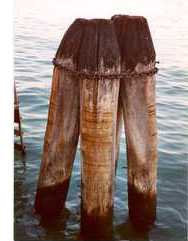
n the areas in which the emersion is the most frequent the dimensions
of the mussels are smaller because the periods during which the mytilus
can feed on small seaweeds and particles of organic material present in
the water are shorter.
The mussel is a sessile
organism, co the main surviving strategy consists in forming very thick
shoals, in which their sharp borders, all turned towards the outside,
represent a solid and with difficulty penetrable carpet (from Bonometto
L., Mizzan L., “Forme e significati – Osservazioni e riflessioni sugli
animali del nostro mare”, Quaderni del Museo Civico di Storia Naturale
di Venezia, Suppl. to Vol. XXXVIII (1987) of the Bollettino del Museo
Civico di Storia Naturale di Venezia).
During the low tide it is possible to see Star ascidians, Sea squirts,
Sponges, Sea anemones.
AOther species typical of this environment aren’t sessile
and have the chance to move to look for more favourable conditions (from
Pellizzato M., Carlotti G., “L’ambiente di riva dei canali di Venezia”,
in “Lavori” della Soc. Ven. Sc. Nat., vol. 5, supplemento ad uso didattico,
pp.50-64, 1981).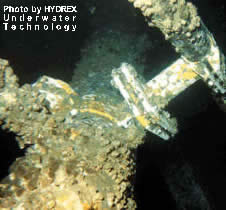
Venice canals offer an ideal environment in which to study the so-called
fouling,
phenomenon, that interests the submerged objects and it is performed by
sea organisms. Observing a stake or some other artificial structures stuck
into the canal, it is interesting to notice how the colonization of this
new environment follows a precise succession
which is also easily observable in any other substrata stuck with the
same methods.
The first organisms are the seaweeds, that do not need a special substratum
on which to settle, as they, having no roots, take their nourishment directly
form their thallous surface. The seaweeds represent the primary fouling.
Afterwards the mussels settle on them (the so-called secondary fouling)
while acorn shells are indifferent to the colonization degree of the substratum
and they can belong to both the primary and to the secondary fouling (
from Cornello M., “Contributo allo studio ecologico delle comunità bentoniche
sessili nella Laguna di Venezia: struttura e dinamica in relazione ai
periodi d'insediamento" – Degree Thesis, A.A. 1994-95, University of Padua).
The outlined situation is typical of the canal environment, but it is
strongly influenced by pollution,
that, most of all in the canals with the least water change, causes a
drastic reduction in the species, leaving free range to the most resistant
ones. |



